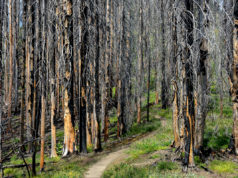Dear EarthTalk: I understand that many of the world’s fisheries are on the brink of collapse, “fished out,” to put it bluntly. How did this happen and what is being done about it? – Mariel LaPlante, New Orleans, LA
Many of the world’s fisheries are indeed in crisis today due to years of overfishing, pollution and habitat destruction. According to the United Nations’ Food and Agriculture Organization, 57 percent of global fish populations are “fully exploited” and another 30 percent are ”overexploited or collapsed.”
This leaves just 13 percent in the “non-fully-exploited” category, down from 40 percent less than four decades ago.
The non-profit Natural Resources Defense Council (NRDC) reports that many of the most popular fish, such as cod, snapper and tuna, are dangerously depleted yet continue to be overfished.
Fishing operations have only been able to satisfy rising demand for fish and shellfish in recent decades by using increasingly high-tech strategies like on-vessel refrigeration and processing, spotter planes and GPS satellites. Furthermore, says Matthew Roney of the non-profit Earth Policy Institute, “Industrial fishing fleets initially targeted the northern hemisphere’s coastal fish stocks, but then as stocks were depleted, they expanded progressively southward on average close to one degree of latitude annually since 1950.”
“The escalating pursuit of fish…has had heavy ecological consequences, including the alteration of marine food webs via a massive reduction in the populations of larger, longer-lived predatory fish such as tunas, cods and marlins,” reports Roney. In addition, he says, sophisticated fishing techniques aimed at maximizing catches, such as longlines and bottom-scraping trawls, kill large numbers of non-target species such as sea turtles, sharks and coral.
Roney is optimistic despite the trends. “In several well-studied regional systems, multiple fisheries have bounced back from collapse after adopting a combination of management measures,” he says. “These include restricting gear types, lowering the total allowable catch, dividing shares of the catch among fishers, and designating marine protected.” He cites an example of Kenyan communities removing beach seine nets and creating “no-take” zones leading to an increase in total fish, fish sizes and fishing income. And no-take reserves established around parts of Australia’s Great Barrier Reef led to a doubling of fish stocks and size within the boundaries of protected areas and larger populations throughout the region.
“It’s not too late to get our fishing practices back on track,” reports NRDC. “Using smart laws, policies, incentives, and market demand, we can help sustain fish populations at healthy levels for years to come.”
The decisions of policymakers play the key role in marine protection, but individual choices and consumer advocacy also make a difference. “We can all support sustainable fishing by wisely choosing which fish to eat, spreading the word to friends and family, and contacting our lawmakers to make sure they support responsible policies,” says NRDC. Consumers can learn which fish are OK to buy by consulting with the Monterey Bay Aquarium’s Seafood Watch program, available for free via the web and phone apps.
CONTACTS: NRDC, www.nrdc.org ; Earth Policy Institute, www.earth-policy.org ; Seafood Watch, www.montereybayaquarium.org/cr/seafoodwatch.aspx
_______________________________________________________________________________________
Dear EarthTalk: I’ve read conflicting reports about the dangers of non-stick cookware. I have a set of older non-stick pans and am not sure if I need to replace them. Are they harmful to use, particularly if they have a few scratches? — Miriam Jones, Montgomery, AL
It may be time to upgrade your pans, given that the U.S. government has called for a complete phase-out of polytetrafluorethylene (PTFE, otherwise known as Teflon) and related products by 2015, due to health concerns. When Teflon is exposed to high heat it can degrade, which causes it to release its constituent chemical, PFOA, as a gas. This phenomenon can kill pet birds, and can’t be good for humans either.
While there are no known cases of airborne PFOA causing direct health problems for consumers, workers in plants where Teflon has been produced are at increased risk for cancers of the pancreas and the male reproductive tract. “Numerous studies have shown that PFOA alters reproductive hormones in the male, causing increased levels of estrogen and abnormal testosterone regulation and that PFOA or chemicals that break down into PFOA damage the thyroid gland,” reports Melissa Breyer of the website Care2.
Breyer adds that four organs or tissues in the immune system and at least nine types of cells that regulate immune function are targets of PFOA, and that scientists have been unable to find a level of PFOA that doesn’t damage the immune system: “Doses given to effected lab animals were minimal—and less, relatively, than levels found in children.” The fact that PFOA exposure led to testicular, pancreatic, mammary and liver tumors in rats doesn’t bode well for what the chemical may do to humans.
Of course, the risk of exposure is much lower for a person frying an egg at home than for a factory worker manufacturing PTFE for DuPont. In 2007, Consumer Reports Magazine tested PTFE-based non-stick pans from several manufacturers and found harmful airborne emissions of PFOA to be minimal. “The highest level was about 100 times lower than levels that animal studies suggest are of concern for ongoing exposure to PFOA,” reported the magazine. “With the aged pans, emissions were barely measurable.”
Some manufacturers are working on safer non-stick cookware using ceramic or silicone coatings free of PTFE or PFOA. But a 2009 survey of eight such alternatives by Cook’s Illustrated magazine did not identify any of the new choices out there high marks. “Not a single one of these ‘green’ pans was without flaws,” said the magazine. “In some, delicate eggs burned, thin fish fillets stuck, and steak charred on the outside while remaining raw within. Others stained or transferred heat inconsistently.” Some pans accumulated the browned bits known as fond when steak was seared, indicating unwanted sticking power.
Many foodies have resigned themselves to the likelihood that the idea of a non-stick pan might in and of itself be too good to be true. As such, cast iron, aluminum, copper and stainless steel each rate high for even heat distribution and for holding up well at high temperatures and frequent use. Used properly—such as by employing a little oil or butter to inhibit food from sticking—such pans can last decades.
CONTACTS: Care2, www.care2.com ; Consumer Reports’ Kitchen Cookware, www.consumerreports.org/cro/kitchen-cookware.htm ; Cook’s Illustrated “Green Skillets,” www.cooksillustrated.com/equipment/overview.asp?docid=20400
EarthTalk® is written and edited by Roddy Scheer and Doug Moss and is a registered trademark of E – The Environmental Magazine (www.emagazine.com). Send questions to: earthtalk@emagazine.com. Subscribe:www.emagazine.com/subscribe. Free Trial Issue: www.emagazine.com/trial.








